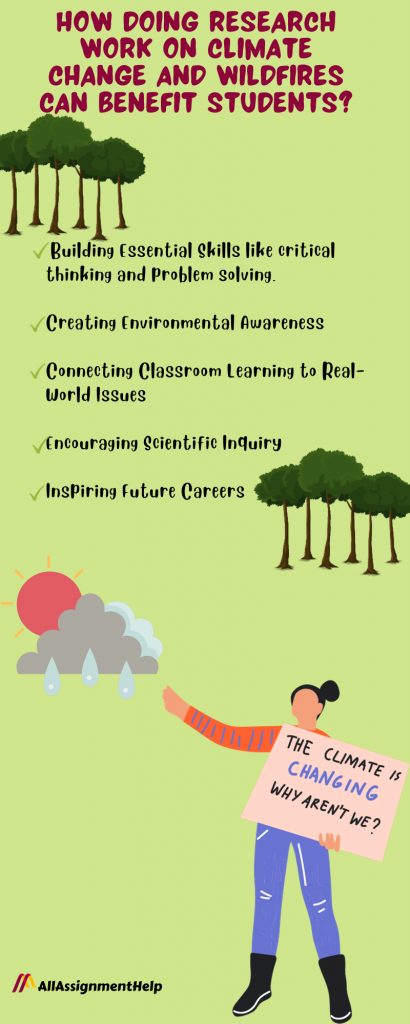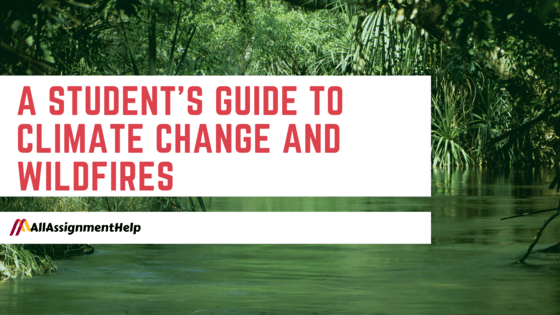Table of Contents
In a time where the climate has had severe changes, climate change and wildfires are something that has not only become occasional but a severe threat to our world. They demand our urgent and recurring attention as it impacts in a very bad way. Do you know that almost 31% of the earth’s land surface is covered with forest? Trees and plants are very important part of our ecosystem as it provides us with so many resourceful things. It sustains our planet by providing clean air to breathe. Human life is possible because of trees and forests as it also helps in conserving biodiversity. Hence, students need to understand the importance and what steps they can take to preserve it for the future.
This blog by AllAssignmentHelp.com aims to guide students in understanding climate change and preventing wildfires. But before moving further let’s discuss what’s is climate change and wildfires in detail.
What are Climate Change and Wildfires?
First, let us shed light on what is climate change. It is like the Earth telling us it’s going through some big changes. It’s not just about whether it’s hot or cold, it’s more about lots of different things happening all over the planet. When we talk about climate change, we mean that the average weather patterns are shifting over a long period. Think of it like the Earth’s long-term weather mood.
Here are a few pointers that indicate that the climate is changing:
- Climate change involves shifts in how hot, cold, wet, or dry places are over a long, long time.
- Rising temperatures, melting ice, and changes in where animals and plants live are like the Earth giving us warning signs.
- People burning lots of fossil fuels, like coal and oil, are making climate change happen faster.
- The ice melting because of climate change can make sea levels rise.
Now, if we talk about wildfires, it is like really big and fast-moving fires that happen in places with lots of trees, grass, or bushes. They can be started by nature or by people, and when they burn, they can be super dangerous.
Here are a few pointers to know it better:
- Wildfires move quickly and can be hard to stop.
- Sometimes, they happen because of nature, like when lightning strikes.
- But, a lot of times, people doing things like leaving campfires unattended or playing with fire can start them too.
Also Read: The Top Five Climate Change Prevention Methods to Learn
How Climate Change and Wildfires Affect Nature?
Wildfires manifest when all the essential elements of the fire triforce converge in a susceptible area. Numerous factors contribute to wildfires, but one prevailing force that stands out is climate change. It has emerged as a primary catalyst behind the surge in forest fires, creating an unfortunate and intricate link between climate change and wildfires.
Amongst various influencers such as the presence of trees, shrubs, soil moisture, high temperature, and potential fuel, climatic changes significantly amplify the risks of wildfires. This amplification is rooted in the strong connections that exist, either directly or indirectly, between the primary factors and climate variability and change. If you do an environment study on global warming then also you can get to know how climate changes happen.
Notably, in the United States alone, the number of large wildfires doubled between 1984 and 2015. This alarming escalation is attributed to climate change, which not only dries the organic matter but also enhances its flammability, intensifying the spread of fires. Consequently, this dried organic matter transforms into a potent forest fuel, contributing to the escalating threat of wildfires.
How Much of the Wildfire is Influenced by Humans?
Not all deadly wildfires are unstoppable. In fact, 90 per cent of them could have been prevented if humans were cautious. Studies indicate that wildfires driven by human activities are posing a significant threat. In the United States alone, 84% of fires reported this year were initiated by humans. According to the U.S. Department of the Interior, the majority of wildland fires are attributed to human causes. Activities that may seem harmless or trivial to people often result in massive fires, such as downed power lines, unattended campfires, and the burning of debris. Some may find it hard to believe, but even the negligent discarding of small cigarettes can lead to wildfires.
Intentional acts of arson are yet another significant human-related reason at the core of these incidents. Despite these human-induced factors, there remain a few natural and unstoppable causes that can ignite a fire, such as lava or lightning.
What Do You Understand by Wildfires?
A wildfire, also known as a wildland fire, is a term given to an uncontrolled fire that occurs in a forest, bushland, grassland, or land sown with crops. When people use terms like bushfire or forest fire, they are referring to specific types of wildland fires. Different terms are used to address the fire depending on the region where it occurs and its characteristics.
The risk of wildfire varies with climate and weather conditions. Drought, wind, and heat can dry out timber or other fuel, making them easy to ignite. The intensity of a small-scale fire is increased by heat, wind, and drought. Topography also affects wildland fires, with the uphill spread being faster and the downhill spread being slower.
You should know about certain wildfire fuels:
Flash Fuels
- Dried grass, leaves, and light branches are considered flash fuels.
- They allow the fire to spread quickly because ignition is quick and easy.
- Flash fuels often generate intense heat that further ignites heavier fuels like limbs, organic matter on the forest floor, and tree stumps.
- These fuels, usually slow to kindle, are difficult to extinguish.
Also Read: Flora and Fauna: Why Is It Important for Humans?
Green Fuels
- Growing vegetation is categorized as green fuels.
- Fuels that are not considered highly flammable but can be burned by an intense fire. Heat or a slight fire can dry out the leaves, allowing for quick ignition.
- Green fuels sometimes pose a special danger: evergreens like cedar, spruce, fir, and pine contain flammable oils. These oils burst into flames when heated by searing drafts from a fire.
How Doing Research Work on Climate Change and Wildfires Can Benefit Students?

Understanding climate change and wildfires isn’t limited to scientists; it’s something that can be incredibly beneficial for students as well. Let’s delve deeper into how students can not only gain knowledge but also actively contribute through research paperwork on these topics. Well, sometimes when they get stuck and look for the best paper writing service. Taking their assistance also benefits students in many ways.
Building Essential Skills
Critical Thinking
Researching climate change and wildfires encourages critical thinking. Students learn to analyze information, identify patterns, and draw informed conclusions.
Problem-Solving
As they explore the complexities of these topics, students develop problem-solving skills. They can propose solutions and contribute ideas to address the challenges created by climate change and wildfires.
Creating Environmental Awareness
Through research papers, students can share their findings with classmates. This helps raise awareness about the impact of climate change and wildfires. This also built a sense of responsibility in them.
Also Read: Greenhouse Effect: Working, Climate Change, Impact on Beings, and Management
Connecting Classroom Learning to Real-World Issues
Researching climate change and wildfires allows students to apply what they learn in the classroom to real-world challenges. It transforms theoretical knowledge into practical understanding. This also helps them make good essays as they can make them a bit personal. Students also utilise essay helper online to add that extra dash of perfection to their essays to get better grades.
Encouraging Scientific Inquiry
Researching these topics involves delving into scientific literature, analyzing data, and drawing conclusions. This also increases their interest in doing scientific research and experiments.
Inspiring Future Careers
Engaging in research on climate change and wildfires can inspire students to consider future careers in environmental science, policy-making, or conservation. It lays the groundwork for a lifelong interest in making a positive impact on the planet.
Last Thoughts!
In simple words, it’s super important for students to learn about climate change and wildfires. Why? Because it’s like being a hero for the Earth. When we know about these things, we can help protect the planet and ourselves. We learn how to stay safe, take care of animals, and even stop big fires from happening. Plus, it’s like having a secret power to make the world better. So, students, by learning about climate change and wildfires, you become Earth heroes, making a real difference for a greener and safer future!
Well, if you want to know more about these things or you have a research paper on this topic and need help with college assignments, you can always get professional assistance and guidance.
Frequently Asked Questions
| Question. Why should students care about climate change and wildfires? Answer. Students should care about climate change and wildfires because it directly affects their future. Understanding these topics helps students become Earth heroes, making small changes that add up to a big impact. It’s about staying safe, protecting animals, and ensuring there are beautiful places to enjoy. By caring now, students shape a better world for themselves and future generations. |
| Question. What can students do to help with climate change and wildfires? Answer. Students can do a lot! Simple actions like saving energy, using less plastic, and being cautious with fire can make a big difference. They can also share what they learn with friends and family, creating a ripple effect of awareness. |
